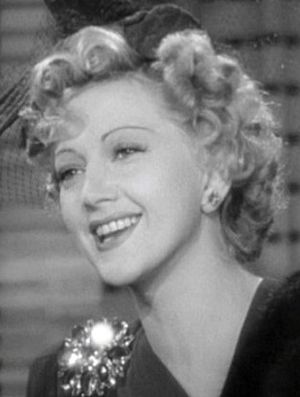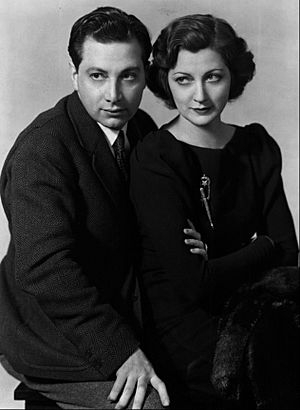Stella Adler facts for kids
Quick facts for kids
Stella Adler
|
|
|---|---|

Adler in Shadow of the Thin Man (1941)
|
|
| Born | February 10, 1901 New York City, U.S.
|
| Died | December 21, 1992 (aged 91) Los Angeles, California, U.S.
|
| Resting place | Mount Carmel Cemetery |
| Alma mater | New York University |
| Occupation |
|
| Years active | 1905–1992 |
| Spouse(s) |
|
| Children | 1 |
| Parent(s) |
|
| Relatives |
|
Stella Adler (born February 10, 1901 – died December 21, 1992) was a famous American actress and a highly respected acting teacher. She started the Stella Adler Studio of Acting in New York City in 1949. Later, she also taught in Los Angeles.
Her grandson, Tom Oppenheim, now runs the New York school. Many famous actors have studied there, including Marlon Brando, Robert De Niro, and Harvey Keitel. The Los Angeles school was run by her friend Irene Gilbert. It continues to be an acting studio today. Actors like Mark Ruffalo and Salma Hayek studied at the Los Angeles school.
Contents
Early Life
Stella Adler was born in Manhattan's Lower East Side in New York City. She was the youngest daughter of Sara and Jacob P. Adler. Her family was a well-known acting family, part of the Jewish American Adler acting dynasty. They were famous in the Yiddish Theater District, a lively theater scene in New York.
Stella started acting when she was just four years old. She performed with her parents' theater company. All five of her brothers and sisters were also actors. Stella became the most famous and important member of her family.
Acting and Teaching Career
Stella Adler began her acting journey at age four in a play called Broken Hearts. She often played roles of both boys and girls. She didn't have much time for school because of her acting. However, she did study at public schools and New York University.
At 18, she performed in London with her father's company. She then returned to New York. In 1922, she made her first English-language appearance on Broadway. She also performed in vaudeville, a type of entertainment with different acts.
In 1922, a famous Russian director named Konstantin Stanislavski visited the U.S. with his Moscow Art Theatre. Stella Adler watched his performances, which greatly influenced her. In 1931, she joined the Group Theatre in New York. This group was founded by Harold Clurman, Lee Strasberg, and Cheryl Crawford. Stella later married Harold Clurman.
The Group Theatre focused on a style of acting called method acting. In 1934, Stella Adler went to Paris to study with Stanislavski himself. She learned that he had changed some of his ideas. He now believed actors should use their imagination to create roles, not just their own memories. When she returned, she disagreed with Lee Strasberg about how to teach method acting.
In 1937, Stella moved to Hollywood and acted in films. She sometimes returned to the Group Theatre. After the group ended in 1941, she went back to New York. She continued to act, direct, and teach. In 1949, she founded her own school, the Stella Adler Conservatory of Theatre.
Over the years, she taught many famous actors. These included Marlon Brando, Robert De Niro, and Warren Beatty. She also taught at New York University and the Yale School of Drama. Stella Adler became one of America's top acting teachers.
She wrote a book called The Technique of Acting in 1988. She performed regularly on Broadway until 1952. She acted in only three films: Love on Toast (1937), Shadow of the Thin Man (1941), and My Girl Tisa (1948). She stopped acting in 1961, after 55 years.
Stanislavski's Influence
Stella Adler was the only member of the Group Theatre to study directly with Konstantin Stanislavski. She disagreed with Lee Strasberg about how to use Stanislavski's ideas. Strasberg focused on "emotional memory," where actors used their own past feelings. Stella believed this was not healthy for actors. She said, "Drawing on the emotions I experienced — for example, when my mother died — to create a role is sick."
When Stella met Stanislavski again, he told her he had moved away from emotional memory. Both Stella and Stanislavski believed that actors needed to do a lot of research. They felt actors should understand the experiences and values of different characters, especially those from other cultures.
Stella taught that actors should use their imagination to understand a scene's "given circumstances." This means thinking about the details of the story and the character's world. She also believed that acting was half internal (imagination, emotion) and half external (how a character walks, talks, and looks).
For example, if a character rides horses, the actor should learn about horse riding. More importantly, actors must study different cultures to understand what situations mean to different people. Stella said without this work, an actor would be "naked" on stage. This approach helped actors like Marlon Brando and Robert De Niro become famous.
Stella also trained actors to use their senses to make characters' experiences feel real. She believed actors needed to master their body and voice to command the stage. She often told her students, "in your choices lies your talent," and encouraged them to make bold and interesting choices for their characters. She also famously said, "don't be boring."
Singer Janis Ian studied with Stella Adler in the 1980s. Janis said Stella had little patience for students who weren't improving. She once told a student to call her mother and go home because she "had no business in the theater."
Personal Life
Stella Adler was married three times. She had one child, a daughter named Ellen. Her second husband was Harold Clurman, a director and critic. Her third husband was Mitchell A. Wilson, a physicist and writer. Stella was also close friends with her sister-in-law, actress Sylvia Sidney.
Stella was a lifelong supporter of the Democratic Party.
Death
Stella Adler passed away on December 21, 1992, at the age of 91. She died from heart failure in Los Angeles. She was buried in Mount Carmel Cemetery in Glendale, New York.
Legacy
Stella Adler's teaching method is known for helping actors create detailed and believable characters. Her approach combined imagination and careful study of the script. Actress Elaine Stritch called Stella Adler "a goddess full of magic and mystery."
In 1991, Stella Adler was honored by being added to the American Theater Hall of Fame.
In 2004, the Harry Ransom Center at the University of Texas at Austin received Stella Adler's complete collection of papers. This collection includes notes, photos, and over 1,100 audio and video recordings of her teaching.
In 2006, she received a star on the Hollywood Walk of Fame after her death. It is located in front of the Stella Adler Theatre in Hollywood.
Stella Adler Schools
The acting schools Stella Adler founded are still open today in New York City and Los Angeles. Her teaching method, which focuses on using an actor's imagination, has been studied by many famous actors. These include Robert De Niro, Elaine Stritch, Martin Sheen, Mark Ruffalo, Salma Hayek, and Marlon Brando. Marlon Brando was even the honorary chairman of the New York studio until he passed away. The Stella Adler Studio of Acting in New York opened a new studio in Los Angeles in 2010, which is run by the Adler family.
Broadway Performances
Stella Adler performed in many Broadway plays. Here are some of them:
- The Straw Hat (1926)
- Big Lake (1927)
- The House of Connelly (1931)
- Success Story (1932)
- Awake and Sing! (1935)
- Paradise Lost (1935)
- He Who Gets Slapped – revival (1946)
See also
 In Spanish: Stella Adler para niños
In Spanish: Stella Adler para niños


